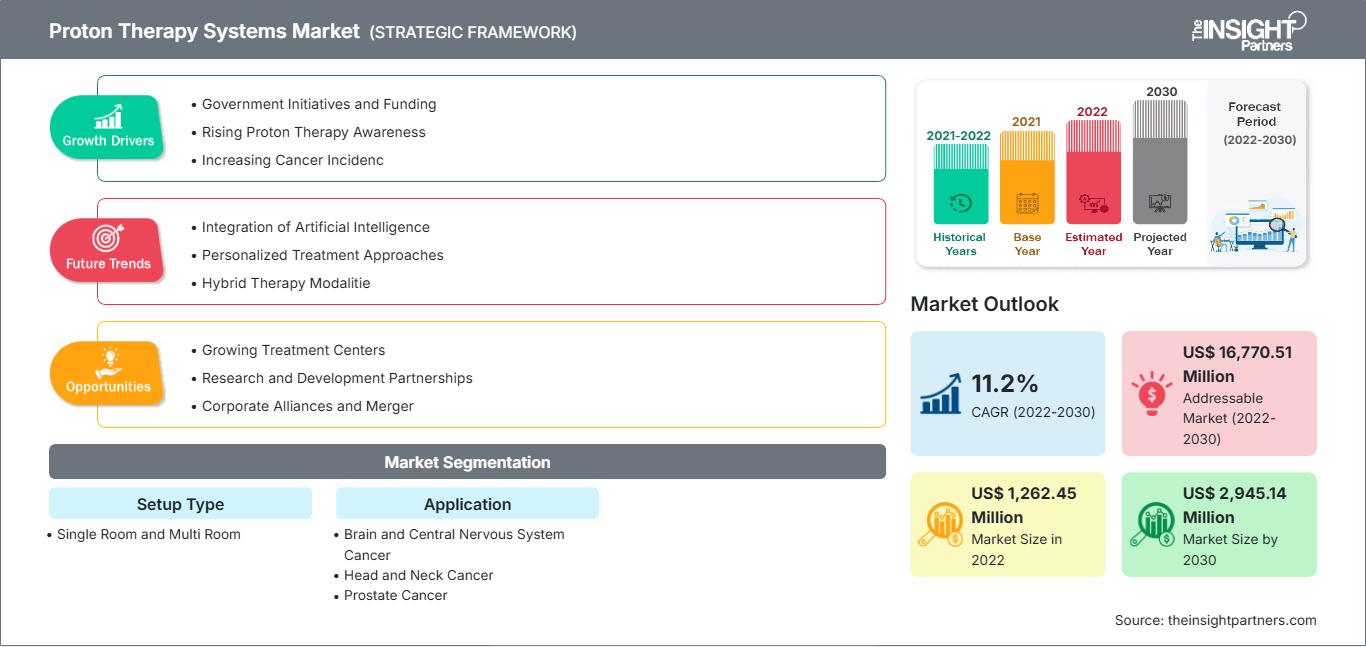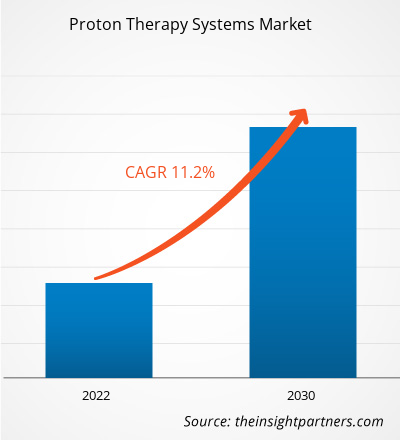[Rapporto di ricerca] Si prevede che il mercato dei sistemi di protonterapia crescerà da 1.262,45 milioni di dollari nel 2022 a 2.945,14 milioni di dollari entro il 2030; si stima che registrerà un CAGR dell'11,2% tra il 2022 e il 2030.
Approfondimenti di mercato e opinioni degli analisti:
Le previsioni di mercato dei sistemi di protonterapia possono aiutare gli stakeholder di questo mercato a delineare le proprie strategie di crescita.
Un sistema di protonterapia è un dispositivo medico avanzato utilizzato per fornire un trattamento radioterapico ad alta precisione per i tumori. Questi sistemi sono di grandi dimensioni e sono costituiti da un acceleratore (ciclotrone), un sistema di trasporto del fascio, un sistema di selezione dell'energia e un'apparecchiatura di irradiazione a portale rotante. Grazie alla sua efficacia nel trattamento di alcuni tipi di cancro, la domanda di protonterapia è in crescita in tutto il mondo. Fattori come la crescente domanda di trattamenti avanzati, con l'aumento dell'incidenza del cancro, e il crescente sostegno governativo ai centri di protonterapia, stimolano la crescita del mercato dei sistemi di protonterapia. Tuttavia, l'elevato costo e l'ampia area di applicazione dei sistemi di protonterapia ostacolano la crescita del mercato. Inoltre, si prevede che la crescente adozione di approcci terapeutici personalizzati, unitamente ai progressi tecnologici, porterà nuove tendenze nel mercato dei sistemi di protonterapia nei prossimi anni.
Fattori di crescita:
La crescente domanda di trattamenti avanzati, con l'aumento dell'incidenza del cancro, traina la crescita del mercato
Secondo l'Agenzia Internazionale per la Ricerca sul Cancro (IARC), i tipi di cancro al polmone, al seno e alla prostata hanno registrato il tasso di incidenza più elevato nel 2022. Queste patologie hanno un tasso standardizzato per età rispettivamente di 23,6, 47,1 e 29,4 casi ogni 100.000 abitanti. Secondo le stime dell'IARC, si prevede che il numero totale di casi di cancro aumenterà da 19,98 milioni nel 2022 a 23,71 milioni entro il 2030 e a 30,97 milioni entro il 2045. Diverse patologie tumorali, come i tumori della testa e del collo (nasale, orale, oculare e laringeo) e i tumori cerebrali, richiedono trattamenti specifici, il che si traduce in un'elevata domanda di approcci terapeutici avanzati come la terapia protonica a intensità modulata (IMPT). Nelle radioterapie tradizionali, come la radioterapia a raggi X, anche il tessuto sano circostante il tumore riceve una dose di radiazioni, che provoca effetti collaterali e può causare tumori secondari. Tuttavia, la terapia protonica contribuisce al trattamento efficace di tumori complessi nel cervello e nella regione testa-collo, riducendo al minimo i danni collaterali ai tessuti circostanti. Pertanto, l'elevata prevalenza di tumori e la domanda di trattamenti avanzati aumentano la domanda di radioterapia protonica, alimentando la crescita del mercato dei sistemi di terapia protonica.
Personalizza questo rapporto in base alle tue esigenze
Potrai personalizzare gratuitamente qualsiasi rapporto, comprese parti di questo rapporto, o analisi a livello di paese, pacchetto dati Excel, oltre a usufruire di grandi offerte e sconti per start-up e università
Mercato dei sistemi di terapia protonica: Approfondimenti strategici

- Ottieni le principali tendenze chiave del mercato di questo rapporto.Questo campione GRATUITO includerà l'analisi dei dati, che vanno dalle tendenze di mercato alle stime e alle previsioni.
Potrai personalizzare gratuitamente qualsiasi rapporto, comprese parti di questo rapporto, o analisi a livello di paese, pacchetto dati Excel, oltre a usufruire di grandi offerte e sconti per start-up e università
Mercato dei sistemi di terapia protonica: Approfondimenti strategici

- Ottieni le principali tendenze chiave del mercato di questo rapporto.Questo campione GRATUITO includerà l'analisi dei dati, che vanno dalle tendenze di mercato alle stime e alle previsioni.
Limitazioni:
Costo elevato e ampia area dei sistemi di protonterapia
Un sistema di protonterapia è un dispositivo medico avanzato utilizzato nel trattamento radioterapico ad alta precisione dei tumori. Si tratta di un dispositivo medico di grandi dimensioni costituito da un acceleratore (ciclotrone), un sistema di trasporto del fascio, un sistema di selezione dell'energia e un'apparecchiatura di irradiazione a portale rotante, che si traduce in ampie superfici e costi elevati delle apparecchiature. Secondo l'Università della Pennsylvania (Oncolink), i ciclotroni dei sistemi di protonterapia pesano fino a 200 tonnellate e hanno un diametro compreso tra 1,8 e 3,7 metri. Il portale può pesare fino a 100 tonnellate e avere un diametro di 12 metri. Secondo uno studio pubblicato (2021) su IOPscience, anche il design compatto (configurazione a sala singola) prevede un'area di 100 mq, mentre i sistemi di protonterapia a più sale occupano tra 200 e 400 mq. di superficie.
Inoltre, i sistemi di protonterapia richiedono un elevato investimento di capitale. Ad esempio, un sistema a sala singola può costare circa 30-50 milioni di dollari. Il costo dei sistemi a protonterapia multi-gantry può partire da 300 milioni di dollari e vengono solitamente installati solo in grandi ospedali e università. Pertanto, gli elevati requisiti di investimento di capitale e le ampie aree di installazione sono tra i fattori che ostacolano la crescita del mercato dei sistemi di protonterapia.
Segmentazione e ambito del rapporto:
L'analisi di mercato dei sistemi di protonterapia è stata condotta considerando i seguenti segmenti: tipo di configurazione e applicazione.
In base al tipo di configurazione, il mercato è suddiviso in sistemi a sala singola e sistemi a sala multipla. Il segmento multi-sala ha detenuto una quota di mercato maggiore dei sistemi di protonterapia nel 2022. Inoltre, si prevede che il segmento mono-sala registrerà un CAGR più rapido durante il periodo di previsione.
Il mercato, per applicazione, è suddiviso in tumori al cervello e al sistema nervoso centrale, tumori della testa e del collo, tumori alla prostata, tumori al seno, tumori ai polmoni, tumori gastrointestinali e altri. Il segmento dei tumori al cervello e al sistema nervoso centrale ha detenuto la quota di mercato maggiore dei sistemi di protonterapia nel 2022 e si prevede che registrerà il CAGR più elevato durante il periodo di previsione.
Analisi regionale:
In termini geografici, l'ambito del rapporto di mercato dei sistemi di protonterapia include Nord America, Europa, Asia-Pacifico, America meridionale e centrale e Medio Oriente e Africa. Nel 2022, il Nord America ha rappresentato la quota di mercato maggiore. La crescente accettazione e adozione dei dispositivi medici più recenti, l'elevata prevalenza di tumori e le innovazioni di prodotto da parte dei principali attori contribuiscono all'espansione delle dimensioni del mercato dei sistemi di protonterapia in Nord America. Secondo le stime dell'American Cancer Society, nel 2023 gli Stati Uniti hanno registrato circa 1,95 milioni di nuovi casi di cancro e circa 0,61 milioni di decessi correlati alla malattia, con un aumento significativo rispetto agli 1,60 milioni di casi di cancro e agli 0,60 milioni di decessi segnalati nel 2020. Secondo il Particle Therapy Co-Operative Group, alla fine del 2023 gli Stati Uniti avevano il numero più alto di sistemi di protonterapia a livello globale, con 46 strutture di trattamento con protonterapia.
Approfondimenti regionali sul mercato dei sistemi di terapia protonica
Le tendenze regionali e i fattori che influenzano il mercato dei sistemi di protonterapia durante il periodo di previsione sono stati ampiamente spiegati dagli analisti di The Insight Partners. Questa sezione illustra anche i segmenti di mercato e la geografia dei sistemi di protonterapia in Nord America, Europa, Asia-Pacifico, Medio Oriente e Africa, America Meridionale e Centrale.
Ambito del rapporto di mercato sui sistemi di terapia protonica
| Attributo del rapporto | Dettagli |
|---|---|
| Dimensioni del mercato in 2022 | US$ 1,262.45 Million |
| Dimensioni del mercato per 2030 | US$ 2,945.14 Million |
| CAGR globale (2022 - 2030) | 11.2% |
| Dati storici | 2021-2022 |
| Periodo di previsione | 2022-2030 |
| Segmenti coperti |
By Tipo di configurazione
|
| Regioni e paesi coperti | Nord America
|
| Leader di mercato e profili aziendali chiave |
|
Densità degli operatori del mercato dei sistemi di terapia protonica: comprendere il suo impatto sulle dinamiche aziendali
Il mercato dei sistemi di protonterapia è in rapida crescita, trainato dalla crescente domanda degli utenti finali, dovuta a fattori quali l'evoluzione delle preferenze dei consumatori, i progressi tecnologici e una maggiore consapevolezza dei benefici del prodotto. Con l'aumento della domanda, le aziende stanno ampliando la propria offerta, innovando per soddisfare le esigenze dei consumatori e sfruttando le tendenze emergenti, alimentando ulteriormente la crescita del mercato.

- Ottieni il Mercato dei sistemi di terapia protonica Panoramica dei principali attori chiave
Sviluppi del settore e opportunità future:
Di seguito sono elencati alcuni sviluppi strategici dei principali attori operanti nel mercato dei sistemi di protonterapia, come riportato nei comunicati stampa aziendali:
- A gennaio 2024, OncoRay ha lanciato il prototipo di un sistema di protonterapia total body guidato da risonanza magnetica (RM) per il monitoraggio in tempo reale dei tumori in movimento mediante risonanza magnetica (RM) durante la protonterapia. La risonanza magnetica aiuta a visualizzare i tumori con un contrasto maggiore, che rappresenta il suo principale vantaggio rispetto alle modalità di imaging convenzionali. Un contrasto migliore consente di delineare meglio il tumore dal tessuto sano circostante e di definire il volume da irradiare con maggiore precisione.
- A dicembre 2023, HKSH Medical Group ha aperto un nuovo centro di protonterapia presso l'HKSH Eastern Medical Centre di A Kung Ngam, Shau Kei Wan, Hong Kong. Il nuovo centro è dotato di un sistema avanzato di protonterapia e di due sale di trattamento all'avanguardia. Il sistema comprende due portali semirotanti per protonterapia, il più recente sistema di trasporto del fascio e un acceleratore basato su sincrotrone.
Panorama competitivo e aziende chiave:
Varian Medical Systems Inc, Sumitomo Heavy Industries Ltd, Hitachi Ltd, Ion Beam Applications SA, Mevion Medical Systems, Provision Healthcare LLC, ProTom International, Optivus Proton Therapy Inc, Advanced Oncotherapy plc e B dot Medical Inc sono tra le aziende di spicco descritte nel rapporto di mercato sui sistemi di protonterapia. Queste aziende si concentrano sullo sviluppo di nuove tecnologie, sull'aggiornamento dei prodotti esistenti e sull'espansione della loro presenza geografica per soddisfare la crescente domanda dei consumatori in tutto il mondo.
- Analisi storica (2 anni), anno base, previsione (7 anni) con CAGR
- Analisi PEST e SWOT
- Valore/volume delle dimensioni del mercato - Globale, Regionale, Nazionale
- Industria e panorama competitivo
- Set di dati Excel
Report recenti
Testimonianze
Motivo dell'acquisto
- Processo decisionale informato
- Comprensione delle dinamiche di mercato
- Analisi competitiva
- Analisi dei clienti
- Previsioni di mercato
- Mitigazione del rischio
- Pianificazione strategica
- Giustificazione degli investimenti
- Identificazione dei mercati emergenti
- Miglioramento delle strategie di marketing
- Aumento dell'efficienza operativa
- Allineamento alle tendenze normative






















 Ottieni un campione gratuito per - Mercato dei sistemi di terapia protonica
Ottieni un campione gratuito per - Mercato dei sistemi di terapia protonica